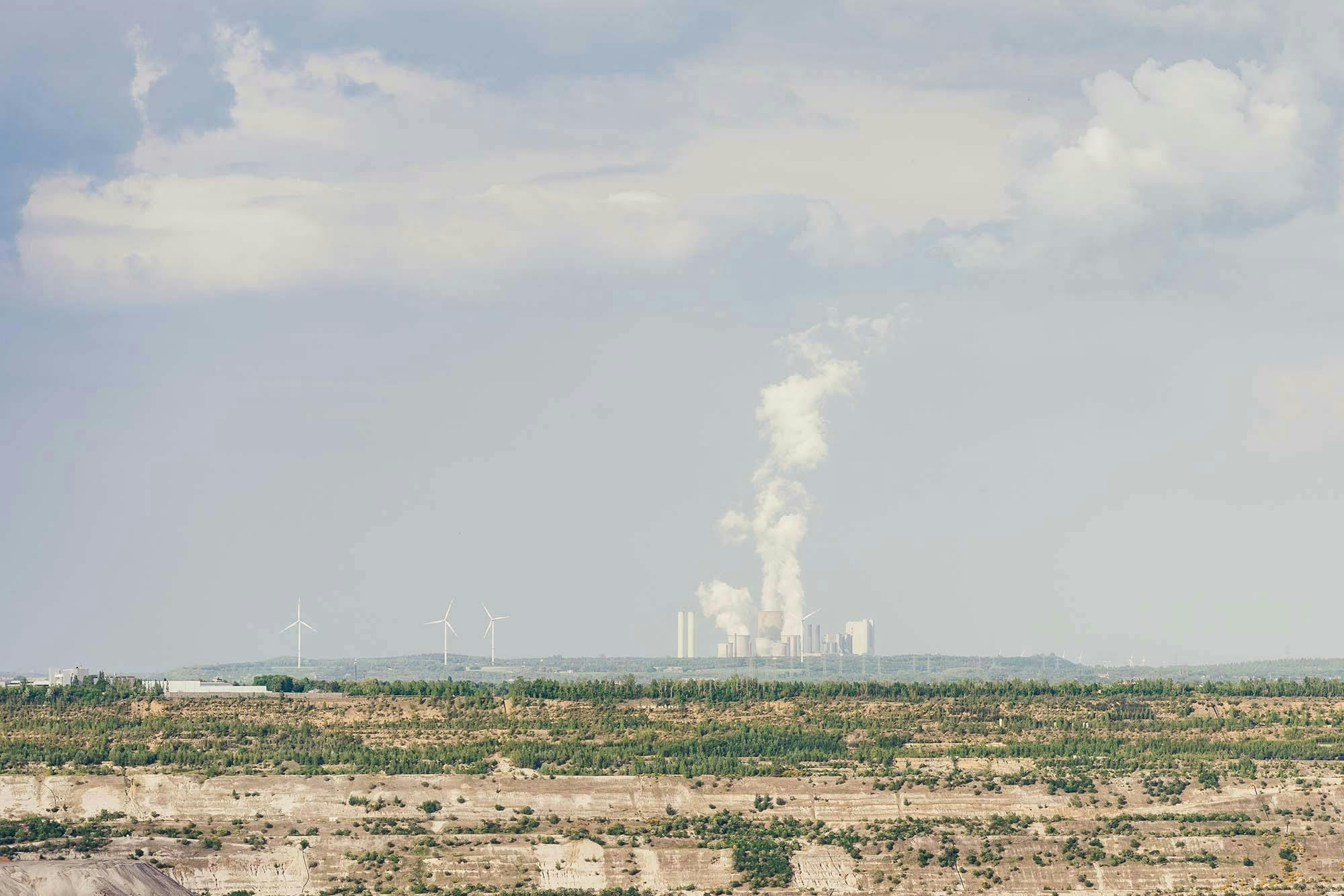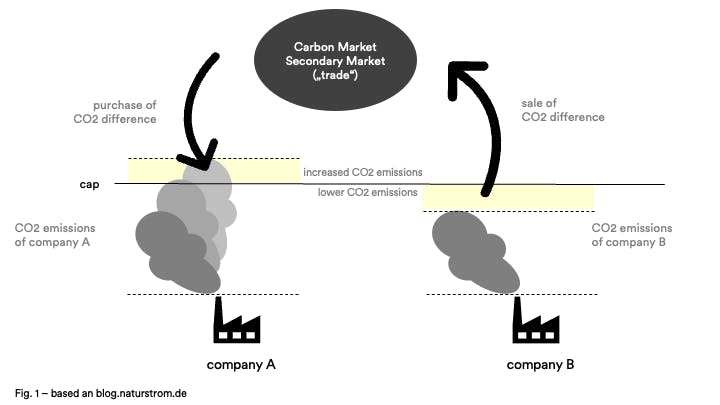Visit us from May 15 to 17 at the GREENTECH FESTIVAL at Messe Berlin. We look forward to seeing you! 👉🏽 Book an appointment at our booth now.

Can Carbon Credits Help
Save the Climate?
“We are running the most dangerous experiment in history right now, which is to see how much carbon dioxide the atmosphere can handle before there is an environmental catastrophe."
This quote is attributed to Tesla and SpaceX CEO Elon Musk. It vividly underscores the urgent need to reduce greenhouse gas emissions and remove CO2 from the atmosphere. Indeed, we are currently hurtling with open eyes towards a disaster. Yet, even as the window for action narrows, there is still time to change course. An effective tool for removing CO2 from the atmosphere is carbon credits. In this blog article, we provide an overview of what carbon credits are – from their definition, to their history, their various applications, to the necessity of their implementation and the challenges associated with them.
Content:
- What are Carbon Credits?
- The Origin of Carbon Credits
- What is Emission Trading?
- The Voluntary Carbon Market
- Applications of Carbon Credits
- Challenges and Outlook
What are Carbon Credits?
Carbon credits are units that quantify the reduction or removal of greenhouse gas emissions. They represent a market-based mechanism that creates incentives and enables actions to reduce or remove carbon dioxide (CO2) and other greenhouse gas emissions from the atmosphere. A carbon credit typically represents one tonne of CO2 equivalent. In simple terms: if one tonne of CO2 is removed from the atmosphere, it can be converted into one carbon credit.
1 Carbon Credit = 1 Tonne of CO2 Equivalent
Besides regulated emission trading, there is also the Voluntary Carbon Market (VCM). Here, companies, organizations, and individuals can purchase carbon credits on a voluntary basis. Buyers thus make a direct contribution to climate protection by financing climate protection projects, while also promoting sustainable development.
The Origin of Carbon Credits
The concept of carbon credits emerged from the United Nations Framework Convention on Climate Change (UNFCCC) and the Kyoto Protocol, which was adopted in 1997. The Kyoto Protocol is an international agreement that commits its parties to reduce greenhouse gas emissions. In this context, carbon credits were introduced, allowing countries to trade emission rights to meet their reduction targets. This is referred to as emissions trading, a government-regulated system. Additionally, there is a voluntary carbon market, which also aims to reduce and remove greenhouse gas emissions.
What is Emission Trading?
Emission trading sets a cap on the amount of greenhouse gases that a company or country can emit. They receive credits for this amount, which they can exchange against emissions. If they emit less CO2, they can sell surplus credits to companies and countries that exceed their limits (known as "cap and trade"; see Figure 1).

Carbon credits are traded, for example, through the EU Emission Trading System (EU ETS), the world's first major carbon market to reduce greenhouse gas emissions. Over the years, the system has been adjusted to tighten the caps and thus reduce total emissions. The EU ETS is considered a model for similar programs worldwide and plays a key role in achieving the European Union's climate goals.
However, there are critics of the emissions trading system. They argue that it allows market participants to buy their way out of responsibility rather than taking real reduction measures. Therefore, it's important to reduce emissions first before offsetting (still) unavoidable emissions through effective climate protection projects. There are also concerns regarding the monitoring and validation of emissions data, which could lead to manipulation. Furthermore, some countries or companies might gain disproportionate advantages from the system, while others are disadvantaged.
The Voluntary Carbon Market
On this market, companies or even individuals purchase carbon credits to offset their own emissions, even if they are not legally required to do so. This is usually done because they want to take responsibility for their carbon footprint and make a positive contribution to the climate, their environment, and society. The money generated from the sale of these credits is invested in projects that reduce emissions or sequester carbon. The climate protection projects by OCELL also operate in the voluntary carbon market: companies invest in local forest projects. The funds raised are used to optimize carbon storage and to convert the forests into climate-resilient mixed forests.
There are, however, critical voices regarding this model. Companies might engage in "greenwashing," using their climate protection investments solely for marketing purposes. Moreover, there are dubious projects – especially in the Global South – whose contribution to climate protection is not always verifiable. Therefore, companies that genuinely want to make a difference are advised to thoroughly research the projects and their providers.
Learn more about how OCELL operates here.
Applications of Carbon Credits
CO2 certificates are used in various sectors worldwide. They support renewable energy, energy efficiency, reforestation projects, and those for improved forest management, sustainable agriculture, and much more. Carbon credits offer companies and individuals incentives to use clean technologies, reduce emissions, and contribute to global climate goals.

Windmills generate renewable energy. (Photography: barnimages)
Renewable Energy
Projects for renewable energy like wind farms, solar power plants, and hydroelectric facilities generate carbon credits based on the amount of clean energy they produce, replacing energy generation from fossil fuels.
Energy Efficiency
Energy efficiency projects in industry, transportation, and buildings help reduce energy consumption and emissions.
Reforestation, Improved Forest Management, and REDD+ Projects
Reforestation projects involve planting trees or restoring forests. Through photosynthesis, trees absorb CO2 from the atmosphere and store it in their biomass. In countries of the Global South, A/R projects may be necessary for reasons such as conversion of forest land to agricultural land, urbanization, and legal and illegal logging for timber production. In Germany, extensive deforestation is prohibited; destroyed forest areas (caused, for example, by wildfires) must be reforested anyway – even without projects financed by CO2 credits. Reforestation projects are therefore not sensible here. Additionally, such projects have the disadvantage that newly planted trees take decades to bind a significant amount of CO2.
Improved Forest Management (IFM) represents another type of forest project. Sustainable practices and strategies for improved forest management are implemented. This also extends the rotation periods of trees, so forests bind more CO2 for longer periods. These projects generate carbon credits by storing carbon and contributing to the conservation and expansion of forest ecosystems.
The approach to Reducing Emissions from Deforestation and Forest Degradation (REDD+) aims to reduce emissions through the protection and sustainable use of forests. These projects combat deforestation and forest degradation while also bringing social and economic benefits. REDD+ projects make a significant contribution to climate protection and promote local development, especially in regions with high rates of deforestation.
OCELL's climate protection projects adopt the approach of improved forest management. Learn more about OCELL's projects here.
Sustainable Agriculture
Methane and nitrous oxide emissions from agriculture are significant. Carbon credits can benefit agriculture by providing incentives for sustainable practices. They can motivate farmers to adopt techniques such as conservation tillage and agroforestry, which bind CO2 and reduce methane emissions. This leads to improved soil quality and increased biodiversity. The sale of carbon credits can also enable investments in more efficient management methods and modern technologies. Thus, farmers not only contribute to climate protection but also benefit financially, leading to more sustainable and environmentally friendly agriculture.
Challenges and Outlook
Carbon credits play a crucial role in the fight against climate change. Yet, projects or their providers are often criticized. Buyers of carbon credits should therefore inform themselves well in advance and pay particular attention to the following criteria.
Measurement and Verification
Accurate measurement and verification of emission reductions pose a challenge for many projects. To ensure the reliability of carbon credits, robust methods and monitoring systems are essential.
Thus, the climate protection projects by OCELL are regularly reviewed and analyzed. Project partners, including forestry operations, continuously document all forestry activities (e.g., recording of damages, and plantings). Additionally, OCELL regularly flies over the forests and evaluates the aerial images. The increase in the forest's carbon storage capacity is also regularly captured using state-of-the-art measuring technology. Independent auditors then review and verify these findings.
Additionality
Another challenge is ensuring additionality. Additionality means that the emission reductions achieved by projects would not have occurred without the incentive of carbon credits. In other words, a climate protection project is additional only if it sequesters carbon that would not have been captured without the project.
To ensure that the project forests of OCELL store more carbon than they would without the project, we work exclusively with professionally managed forestry operations. If their main source of income was previously timber production, they can now increase the rotation periods and thus the age and carbon storage of the trees through project revenues. OCELL's project partners extend the average lifespan of the trees, resulting in more carbon being sequestered. This additional carbon is then compared to the baseline scenario – a reliable calculation of what would have happened without the project if forestry management had continued as usual.
Permanence
The permanence of carbon projects refers to the long-term sequestration of carbon. The carbon captured by a climate protection project must be securely stored over an extended period and not released back into the atmosphere.
OCELL's project partners commit to enhancing their forest's carbon storage and promoting biodiversity for at least 30 years. The project can be extended indefinitely.
Double Counting
Double counting presents a significant challenge for the global market. It occurs when the same emission reductions are attributed to multiple market participants, for example, Germany and a company. To prevent this, strict standards and monitoring systems must be introduced to ensure that each ton of CO2 is only counted once and that the projects genuinely lead to sustainable emission reductions. This is crucial to ensure the effectiveness of carbon credits in the fight against climate change.
"To stop global warming, removing CO2 is essential - in addition to reducing CO2 emissions."
- University of Oxford -
The scientific community agrees: To halt climate change, we must emit less CO2 and additionally remove existing CO2 from the atmosphere immediately and on a large scale, as per an Oxford study. To achieve the 1.5-degree goal of the Paris Climate Agreement, we have less time than previously thought. According to a study by Imperial College London, our global "CO2 budget" could be depleted by 2029. Carbon credits from IFM (Improved Forest Management) projects are an effective tool for storing carbon and combating climate change – when properly implemented.
OCELL’s solution for a significant contribution to climate protection are data-driven, local projects for improved forest management. Forests are converted into climate-resilient mixed forests that draw more CO2 from the atmosphere.
Learn more about OCELL's climate protection projects here.